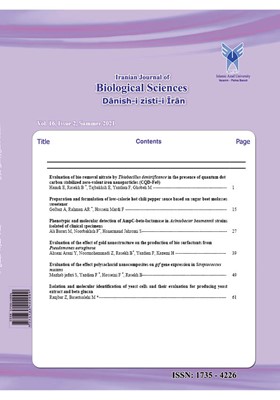Evaluation of the effect polysacharid nanocomposites on gtf gene expression in Streptococcus mutan
Subject Areas : nanobiotechnology
Shokofeh Mazhab jafari
1
,
fatemeh Yazdian
2
*
,
Farzaneh Hosseini
3
![]() ,
behnam rasekh
4
,
behnam rasekh
4
1 - Bioscience college, Islamic Azad University, Tehran North Branch, Tehran, Iran
2 - Department of Life Science Engineering, Faculty of New Science and Technologies, University of Tehran, Tehran, Iran
3 - Bioscience college, Islamic Azad University, Tehran North Branch, Tehran, Iran
4 - director of environment and biotechnology research division
Keywords: Gene expression, Polysaccharide, Streptococcus mutans, Dental biofilm,
Abstract :
Tooth decay is one of the most important public health problems in different communities. The activity of acid-producing bacteria, especially Streptococcus mutans biofilms, is the main cause of this complication. The formation of biofilms of this bacterium depends on the presence of the enzyme glucosyltransferase, which is encoded by the gtf gene. The aim of this study was to evaluate the effect of polysaccharide nanocomposite of Chitosan (Cs)/Carboxymethyl Starch (CMS)/Graphene oxide (RGO)/Silica (SiO2) on gtf gene expression in Streptococcus mutans. Graphene oxide was synthesized by Hummers method. Chitosan/Carboxymethyl Starch/Graphene oxide/Silica quaternary compound were then prepared and antimicrobial effect was investigated and antimicrobial effect on Streptococcus's mutans ATCC 35668 was investigated by microdilution method. The morphology and structural properties were investigated by FTIR, SEM and DLS. The expression of gtfB, gtfC, gtfD genes was examined by RT-PCR technique. FTIR studies confirmed the incorporation of RGO and SiO2 into nanocomposite. The antimicrobial effect of nanocomposite (0.203 mg/ml) was obtained. RT-PCR results showed that no significant relationship was observed in the expression of gtfB and gtfD genes in cells treated with nanocomposites compared to the control group (P=0.187, P=0.067), while the expression of gtfC gene was significantly reduced (P=0.049) in cells treated with nanocomposite and indicating the strong effect of this nanocomposite on suppressing the gtfC gene and reducing biofilm formation. According to the results, the expression level of gftC gene in cells treated with nanocomposite was reduced, and Cs/CMS/RGO/SiO2 nanocomposite has a strong effect in suppressing gtfC gene.
_||_

